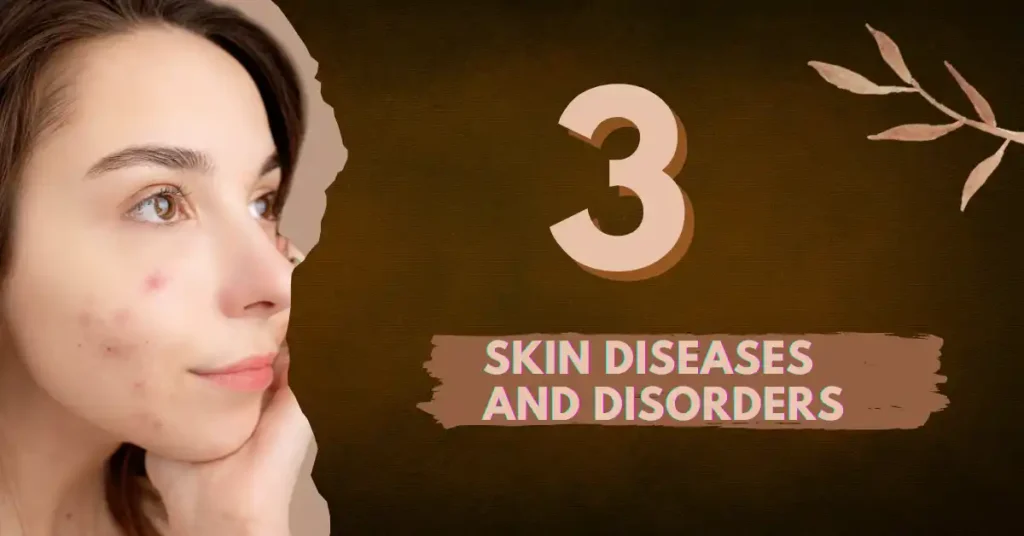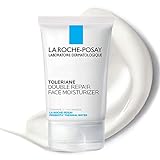Introduction:
Recognising and understanding skin diseases and disorders is of utmost importance for the protection and well-being of both beauticians and their clients. While some conditions require referral to dermatologists, beauticians play a vital role in managing common disorders such as acne, rosacea, and sensitive skin.
1. Acne

Definition and Causes of Acne:
Acne is a common skin condition that occurs when the hair follicles become blocked with a combination of sebum (an oily substance produced by the skin), dead skin cells, and bacteria. This results in the formation of various types of lesions, including blackheads (open comedones) and whiteheads (closed comedones).
Causes of Acne:
It’s important to note that the exact cause of acne can vary from person to person, and multiple factors often contribute to its development. Genetic predisposition can also play a role in determining an individual’s susceptibility to acne.
By understanding the causes of acne, aestheticians can better address their clients’ concerns and recommend appropriate skincare routines and treatments to manage and improve the condition.
Acne Levels:
Acne can be classified into different levels or grades, indicating the severity of the condition.
- Grade I: Minor breakouts, mostly open comedones, some closed comedones, and a few papules and pustules.
- Grade II: More closed comedones, increased number of open comedones, and a greater presence of papules and pustules.
- Grade III: Red and inflamed, with many papules and pustules.
- Grade IV: Cystic acne, featuring cysts along with comedones, papules, pustules, and inflammation are present.
2. Rosacea

Rosacea is a chronic inflammatory skin condition that primarily affects the face, especially the cheeks and nose.
- Symptoms include persistent redness, flushing, visible blood vessels (telangiectasia), and the development of papules and pustules.
- Triggers such as spicy food, alcohol, caffeine, extreme temperatures, and stress can exacerbate rosacea symptoms.
- Beauticians can use soothing and calming ingredients and treatments to reduce redness and inflammation.
3. Sensitive Skin Diseases:

Sensitive skin requires gentle and specialised care due to its heightened reactivity to various environmental and topical factors.
Definition and Characteristics:
- It is prone to redness, dryness, itching, and a burning sensation.
- Causes include genetic predisposition, impaired skin barrier function, and external factors such as harsh products or excessive sun exposure.
- Beauticians should prioritise the use of gentle and hypoallergenic products for sensitive skin.
- Patch testing helps identify potential allergens or irritants to avoid adverse reactions.
Referral to Dermatologist:
Recognising when to refer clients to dermatologists is crucial for optimal care and management of skin conditions.
- Beauticians should be aware of limitations within their scope of practice and recognise conditions requiring specialised medical expertise.
- Referring clients to dermatologists ensures accurate diagnosis, appropriate treatment, and monitoring of skin conditions.
- Dermatologists possess specialised knowledge, advanced diagnostic tools, and a range of treatment options.
- Collaboration between beauticians and dermatologists ensures comprehensive and tailored care for clients.
Beautician’s Role in Skin Care:

Beauticians have a significant role in providing care and support for common skin concerns.
- Educating clients on proper skincare routines, including cleansing, exfoliation, and moisturisation.
- Recommending suitable products for home care and discussing their application.
- Performing professional treatments to address specific skin issues and improve overall skin health and appearance.
- Providing guidance on lifestyle factors that impact the skin, such as diet, stress management, and sun protection.
- Collaborating with dermatologists and other healthcare professionals to ensure holistic and integrated care for clients’ skin health.
List of Dermatologically Tested Skin Care Products and Their Uses.
Acne Skin Diseases
1. Neutrogena Oil-Free Acne Wash
- Description: Neutrogena’s Oil-Free Acne Wash is a dermatologist-recommended cleanser designed to combat acne. It contains salicylic acid, which unclogs pores and helps prevent future breakouts.
- How to Use: Apply a small amount to wet hands and work into a lather. Gently massage onto your face, then rinse thoroughly. Use daily for best results.
2. La Roche-Posay Effaclar Duo Dual Action Acne Treatment
- Description: La Roche-Posay’s Effaclar Duo is a potent acne treatment that helps reduce blemishes, unclog pores, and prevent new acne from forming. It contains micronized benzoyl peroxide and micro-exfoliating LHA.
- How to Use: Apply a thin layer to affected areas once or twice daily. Use sunscreen during the day, as this product may increase sensitivity to the sun.
3. CeraVe Acne Foaming Cream Cleanser
- Description: CeraVe’s Acne Foaming Cream Cleanser is a gentle yet effective cleanser that helps clear acne while maintaining the skin’s natural barrier. It contains benzoyl peroxide.
- How to Use: Wet your skin and gently massage the cleanser into a lather. Rinse thoroughly. Use once daily or as directed by a dermatologist.
4. Differin Adapalene Gel 0.1% Acne Treatment
- Description: Differin Adapalene Gel is an FDA-approved acne treatment that helps regulate skin cell turnover and reduce inflammation. It contains adapalene, a retinoid.
- How to Use: Apply a thin layer to the affected area once daily, preferably in the evening. Use sunscreen during the day.
5. EltaMD UV Clear Broad-Spectrum SPF 46
- Description: EltaMD UV Clear is a dermatologist-recommended sunscreen that is suitable for sensitive skin. It provides broad-spectrum protection and calms irritated skin with niacinamide.
- How to Use: Apply liberally to the face and neck 15 minutes before sun exposure. Reapply every 2 hours when outdoors.
Rosacea Skin Diseases
1. EltaMD UV Clear Broad-Spectrum SPF 46
- Description: EltaMD UV Clear is a dermatologist-recommended sunscreen that is suitable for sensitive skin. It provides broad-spectrum protection and calms irritated skin with niacinamide.
- How to Use: Apply liberally to the face and neck 15 minutes before sun exposure. Reapply every 2 hours when outdoors.
2. Eucerin Redness Relief Night Creme
- Description: Eucerin’s Redness Relief Night Creme is specially formulated for rosacea-prone skin. It contains soothing licorice root extract and reduces redness overnight.
- How to Use: Apply a small amount to your face in the evening after cleansing. Gently massage into the skin.
3. Avene Antirougeurs Calm Soothing Repair Mask
- Description: Avene’s Antirougeurs Calm Soothing Repair Mask is a calming and hydrating mask that provides instant relief for rosacea-prone skin. It contains Avene’s thermal spring water.
- How to Use: Apply a generous layer to clean, dry skin. Leave on for 10-15 minutes, then gently rinse with lukewarm water.
4. Dr. Jart+ Cicapair Tiger Grass Color Correcting Treatment
- Description: Dr. Jart+ Cicapair Tiger Grass Color Correcting Treatment is a green-to-beige cream that neutralizes redness and provides SPF protection. It contains centella asiatica.
- How to Use: Apply a small amount to the face as the last step in your skincare routine. It can be used alone or under makeup.
Sensitive Skin Diseases
1. Cetaphil Gentle Skin Cleanser
- Description: Cetaphil Gentle Skin Cleanser is a mild and non-irritating cleanser suitable for sensitive skin. It effectively removes impurities without overdrying.
- How to Use: Apply a generous amount to your face and massage gently. Rinse with lukewarm water. Can be used with or without water.
2. Vanicream Moisturizing Cream
- Description: Vanicream Moisturizing Cream is a rich and emollient moisturizer that soothes and hydrates sensitive skin. It is free of common irritants and fragrance.
- How to Use: Apply as often as needed to the face and body. It can be used on damp skin for extra hydration.
3. La Roche-Posay Toleriane Double Repair Face Moisturizer
- Description: La Roche-Posay Toleriane Double Repair Face Moisturizer is a lightweight and hydrating moisturizer that restores the skin’s natural barrier. It contains ceramides and niacinamide.
- How to Use: Apply to the face and neck morning and evening after cleansing.
Conclusion:
Understanding and addressing common skin diseases and disorders are essential for beauticians to provide effective and safe care. While some conditions require referral to dermatologists, beauticians play a crucial role in managing and supporting clients with conditions such as acne, rosacea, and sensitive skin. By staying informed and collaborating with dermatologists, beauticians can contribute to the well-being and improved skin health of their clients.
Affiliate disclosure
Kindly take notice that this post may includes hyperlinks that qualify as affiliate links. As a result, I may become eligible to receive a modest commission, without any expense to you, in the event of a purchase made through these hyperlinks featured on this website.Cosmeticknowledge.com is a participant in the Amazon Services LLC Associates Program
https://www.youtube.com/channel/UCwivHo24VuhS0Lj54pzGScA
https://www.facebook.com/profile.php?id=100093483188011
FREQUENTLY ASKED QUESTIONS (FAQS)
What is acne, and what causes it?
Acne is a common skin condition characterised by blocked hair follicles, resulting in various lesions like blackheads and whiteheads. It is caused by a combination of factors including sebum, dead skin cells, and bacteria. Genetic predisposition can also contribute to its development.
How is acne classified or graded?
Acne can be classified into four grades:
Grade I: Minor breakouts with open and closed comedones, and a few papules and pustules.
Grade II: More comedones, papules, and pustules.
Grade III: Red and inflamed with many papules and pustules.
Grade IV: Cystic acne with cysts, comedones, papules, pustules, and inflammation.
What is rosacea, and what are its common symptoms?
It is a chronic inflammatory skin condition that primarily affects the face, particularly the cheeks and nose. Common symptoms include persistent redness, flushing, visible blood vessels, and the development of papules and pustules.
What triggers or exacerbates rosacea?
Triggers for rosacea can include spicy food, alcohol, caffeine, extreme temperatures, and stress. These factors can worsen symptoms in individuals with it.
How can beauticians help clients with rosacea?
Beauticians can use soothing and calming ingredients and treatments to reduce redness and inflammation in clients with rosacea.
What characterises sensitive skin, and what are its common causes?
Sensitive skin is prone to redness, dryness, itching, and a burning sensation. Causes can include genetic predisposition, impaired skin barrier function, and external factors like harsh products or excessive sun exposure.
How should beauticians care for sensitive skin?
Beauticians should prioritise the use of gentle and hypoallergenic products for sensitive skin. Additionally, patch testing can help identify potential allergens or irritants to avoid adverse reactions.












